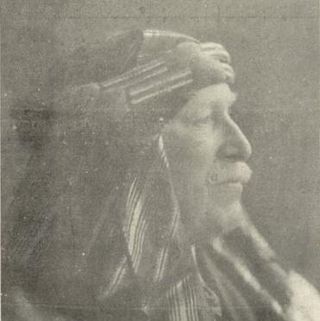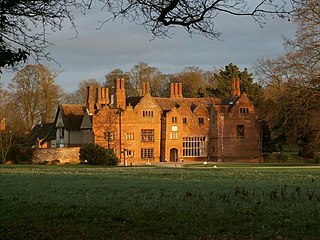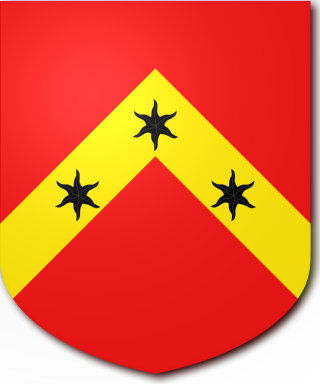
Edward Montagu, 2nd Earl of Manchester, KG, KB, FRS was an important commander of Parliamentary forces in the First English Civil War, and for a time Oliver Cromwell's superior.

Earl Ferrers is a title in the Peerage of Great Britain. It was created in 1711 for Robert Shirley, 14th Baron Ferrers of Chartley. The Shirley family descends from George Shirley of Astwell Castle, Northamptonshire. In 1611 he was created a Baronet, of Staunton Harold in the County of Leicester, in the Baronetage of England. He was succeeded by his son Henry, the second Baronet, who married Lady Dorothy Devereux, daughter of Robert Devereux, 2nd Earl of Essex. On the death of her brother Robert Devereux, 3rd Earl of Essex, she became the youngest co-heir to the baronies of Ferrers of Chartley and the barony of Bourchier, which had fallen into abeyance on the death of the third Earl. Shirley was succeeded by his eldest son, the third Baronet. He died unmarried and was succeeded by his younger brother, the fourth Baronet. He was imprisoned in the Tower of London by Cromwell and died there in 1656. On his death the title passed to his eldest son, the fifth Baronet. He died at an early age and was succeeded at birth by his posthumous son, the sixth Baronet.

Baron FitzWalter is an ancient title in the Peerage of England. It was created on 24 June 1295 for Robert FitzWalter. The title was created by writ, which means that it can descend through both male and female lines.

Earl of Guilford is a title that has been created three times in history. The title was created for the first time in the Peerage of England in 1660 for Elizabeth Boyle. She was a daughter of William Feilding, 1st Earl of Denbigh, and the widow of Lewis Boyle, 1st Viscount Boyle of Kinalmeaky. The title was for life only and became extinct on her death in 1667. The title was created for a second time in the Peerage of England in 1674 for John Maitland, 1st Duke of Lauderdale. For more information on this creation, see the article on him as well as the Earl of Lauderdale.

Thomas Parker, 1st Earl of Macclesfield, was an English Whig politician who sat in the House of Commons from 1705 to 1710. He was Lord Chief Justice from 1710 to 1718 and acted briefly as one of the regents before the arrival of King George I in Britain. His career ended when he was convicted of corruption on a massive scale and he spent the later years of his life in retirement at his home, Shirburn Castle in Oxfordshire.

The title Marquess of Halifax was created in the Peerage of England in 1682 for the George Savile, 1st Earl of Halifax.

The title Earl Castleton, of Sandbeck in the County of York, was created in the Peerage of Great Britain in 1720 for the 6th Viscount Castleton, who had previously been created Baron Saunderson, of Saxby in the County of Lincoln, in 1714, and Viscount Castleton, of Sandbeck in the County of York, in 1716, both also in the Peerage of Great Britain.

Lord Headley, Baron Allanson and Winn, of Aghadoe in the County of Kerry, was a title in the Peerage of Ireland. It was created in 1797 for Sir George Allanson-Winn, 1st Baronet, a former Baron of the Court of the Exchequer and Member of Parliament for Ripon. He had already been created a Baronet, of Little Warley in the County of Essex, in the Baronetage of Great Britain on 14 September 1776. His son, Charles Winn-Allanson, 2nd Baron Headley, represented Ripon, Malton and Ludgershall in Parliament. In 1833 he succeeded a distant relative as 8th Baronet, of Nostel. His nephew, the third Baron, sat in the House of Lords as an Irish Representative Peer from 1868 to 1877. His son, the fourth Baron, was an Irish Representative Peer from 1883 to 1913. His cousin, Rowland Allanson-Winn, 5th Baron Headley, was a prominent convert to Islam. On the death in 1994 of the latter's younger son, Charles Allanson-Winn, 7th Baron Headley, the titles became extinct.
The High Sheriff of Essex was an ancient sheriff title originating in the time of the Angles, not long after the invasion of the Kingdom of England, which was in existence for around a thousand years. On 1 April 1974, under the provisions of the Local Government Act 1972, the title of Sheriff of Essex was retitled High Sheriff of Essex. The high shrievalties are the oldest secular titles under the Crown in England and Wales, their purpose being to represent the monarch at a local level, historically in the shires.

Spains Hall is an Elizabethan country house near Finchingfield in Essex, England. The building has been Grade I listed since 1953.
There have been four baronetcies created for persons with the surname Rich, two in the Baronetage of England, one in the Baronetage of Great Britain and one in the Baronetage of the United Kingdom. As of 2008 three of the creations are extinct while one is dormant.

The Carr Baronetcy, of Sleaford in the County of Lincolnshire, is a title in the Baronetage of England. It was created on 29 June 1611 for Edward Carr who was Sheriff of Lincolnshire in 1614. The 3rd Baronet was Chancellor of the Duchy of Lancaster and a Member of Parliament for Lincolnshire in the House of Commons.
Robert Kemp may refer to:
Sir William Armine, 2nd Baronet was an English politician who sat in the House of Commons from 1646 to 1653.
The Jenoure Baronetcy, of Much Dunmow in the County of Essex, was a title in the Baronetage of England. It was created on 30 July 1628 for Kenelm Jenoure. The title became extinct on the death of the sixth Baronet in 1755.
Sir John Burgoyne, 1st Baronet was an English politician who sat in the House of Commons from 1645 to 1648. He supported the Parliamentarian cause in the English Civil War.
There have been two baronetcies created for persons with the surname Mildmay, one in the Baronetage of England and one in the Baronetage of Great Britain. Both are extinct.

Christ Church, Ottershaw is a Church of England church on Guildford Road in the village of Ottershaw in the Runnymede district of Surrey, England, about 20 miles south-west of London. Grade II listed, it was designed by Sir George Gilbert Scott (1811–78).
Thomas Jervoise was an English politician.
Sir John Wentworth, 1st Baronet, of Gosfield, Essex, was an English aristocrat.








